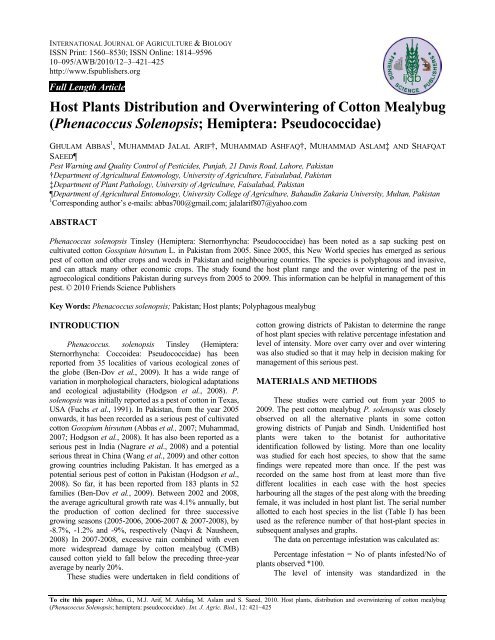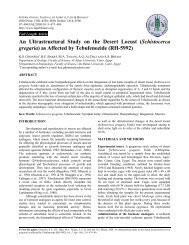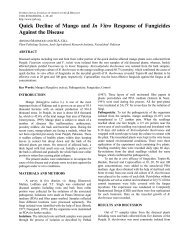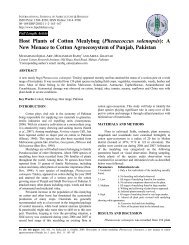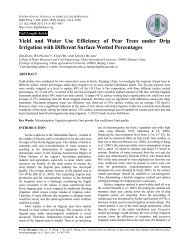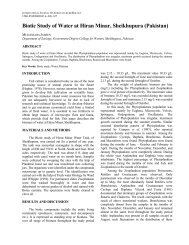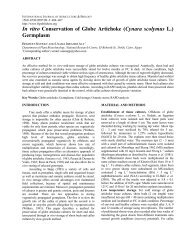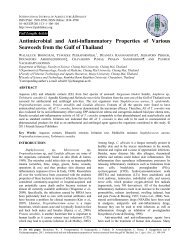Host Plants Distribution and Overwintering of ... - Fspublishers.org
Host Plants Distribution and Overwintering of ... - Fspublishers.org
Host Plants Distribution and Overwintering of ... - Fspublishers.org
You also want an ePaper? Increase the reach of your titles
YUMPU automatically turns print PDFs into web optimized ePapers that Google loves.
INTERNATIONAL JOURNAL OF AGRICULTURE & BIOLOGY<br />
ISSN Print: 1560–8530; ISSN Online: 1814–9596<br />
10–095/AWB/2010/12–3–421–425<br />
http://www.fspublishers.<strong>org</strong><br />
Full Length Article<br />
<strong>Host</strong> <strong>Plants</strong> <strong>Distribution</strong> <strong>and</strong> <strong>Overwintering</strong> <strong>of</strong> Cotton Mealybug<br />
(Phenacoccus Solenopsis; Hemiptera: Pseudococcidae)<br />
GHULAM ABBAS 1 , MUHAMMAD JALAL ARIF†, MUHAMMAD ASHFAQ†, MUHAMMAD ASLAM‡ AND SHAFQAT<br />
SAEED<br />
Pest Warning <strong>and</strong> Quality Control <strong>of</strong> Pesticides, Punjab, 21 Davis Road, Lahore, Pakistan<br />
†Department <strong>of</strong> Agricultural Entomology, University <strong>of</strong> Agriculture, Faisalabad, Pakistan<br />
‡Department <strong>of</strong> Plant Pathology, University <strong>of</strong> Agriculture, Faisalabad, Pakistan<br />
Department <strong>of</strong> Agricultural Entomology, University College <strong>of</strong> Agriculture, Bahaudin Zakaria University, Multan, Pakistan<br />
1 Corresponding author’s e-mails: abbas700@gmail.com; jalalarif807@yahoo.com<br />
ABSTRACT<br />
Phenacoccus solenopsis Tinsley (Hemiptera: Sternorrhyncha: Pseudococcidae) has been noted as a sap sucking pest on<br />
cultivated cotton Gosspium hirsutum L. in Pakistan from 2005. Since 2005, this New World species has emerged as serious<br />
pest <strong>of</strong> cotton <strong>and</strong> other crops <strong>and</strong> weeds in Pakistan <strong>and</strong> neighbouring countries. The species is polyphagous <strong>and</strong> invasive,<br />
<strong>and</strong> can attack many other economic crops. The study found the host plant range <strong>and</strong> the over wintering <strong>of</strong> the pest in<br />
agroecological conditions Pakistan during surveys from 2005 to 2009. This information can be helpful in management <strong>of</strong> this<br />
pest. © 2010 Friends Science Publishers<br />
Key Words: Phenacoccus solenopsis; Pakistan; <strong>Host</strong> plants; Polyphagous mealybug<br />
INTRODUCTION<br />
Phenacoccus. solenopsis Tinsley (Hemiptera:<br />
Sternorrhyncha: Coccoidea: Pseudococcidae) has been<br />
reported from 35 localities <strong>of</strong> various ecological zones <strong>of</strong><br />
the globe (Ben-Dov et al., 2009). It has a wide range <strong>of</strong><br />
variation in morphological characters, biological adaptations<br />
<strong>and</strong> ecological adjustability (Hodgson et al., 2008). P.<br />
solenopsis was initially reported as a pest <strong>of</strong> cotton in Texas,<br />
USA (Fuchs et al., 1991). In Pakistan, from the year 2005<br />
onwards, it has been recorded as a serious pest <strong>of</strong> cultivated<br />
cotton Gosspium hirsutum (Abbas et al., 2007; Muhammad,<br />
2007; Hodgson et al., 2008). It has also been reported as a<br />
serious pest in India (Nagrare et al., 2008) <strong>and</strong> a potential<br />
serious threat in China (Wang et al., 2009) <strong>and</strong> other cotton<br />
growing countries including Pakistan. It has emerged as a<br />
potential serious pest <strong>of</strong> cotton in Pakistan (Hodgson et al.,<br />
2008). So far, it has been reported from 183 plants in 52<br />
families (Ben-Dov et al., 2009). Between 2002 <strong>and</strong> 2008,<br />
the average agricultural growth rate was 4.1% annually, but<br />
the production <strong>of</strong> cotton declined for three successive<br />
growing seasons (2005-2006, 2006-2007 & 2007-2008), by<br />
-8.7%, -1.2% <strong>and</strong> -9%, respectively (Naqvi & Nausheen,<br />
2008) In 2007-2008, excessive rain combined with even<br />
more widespread damage by cotton mealybug (CMB)<br />
caused cotton yield to fall below the preceding three-year<br />
average by nearly 20%.<br />
These studies were undertaken in field conditions <strong>of</strong><br />
cotton growing districts <strong>of</strong> Pakistan to determine the range<br />
<strong>of</strong> host plant species with relative percentage infestation <strong>and</strong><br />
level <strong>of</strong> intensity. More over carry over <strong>and</strong> over wintering<br />
was also studied so that it may help in decision making for<br />
management <strong>of</strong> this serious pest.<br />
MATERIALS AND METHODS<br />
These studies were carried out from year 2005 to<br />
2009. The pest cotton mealybug P. solenopsis was closely<br />
observed on all the alternative plants in some cotton<br />
growing districts <strong>of</strong> Punjab <strong>and</strong> Sindh. Unidentified host<br />
plants were taken to the botanist for authoritative<br />
identification followed by listing. More than one locality<br />
was studied for each host species, to show that the same<br />
findings were repeated more than once. If the pest was<br />
recorded on the same host from at least more than five<br />
different localities in each case with the host species<br />
harbouring all the stages <strong>of</strong> the pest along with the breeding<br />
female, it was included in host plant list. The serial number<br />
allotted to each host species in the list (Table I) has been<br />
used as the reference number <strong>of</strong> that host-plant species in<br />
subsequent analyses <strong>and</strong> graphs.<br />
The data on percentage infestation was calculated as:<br />
Percentage infestation = No <strong>of</strong> plants infested/No <strong>of</strong><br />
plants observed *100.<br />
The level <strong>of</strong> intensity was st<strong>and</strong>ardized in the<br />
To cite this paper: Abbas, G., M.J. Arif, M. Ashfaq, M. Aslam <strong>and</strong> S. Saeed, 2010. <strong>Host</strong> plants, distribution <strong>and</strong> overwintering <strong>of</strong> cotton mealybug<br />
(Phenacoccus Solenopsis; hemiptera: pseudococcidae) . Int. J. Agric. Biol., 12: 421–425
following ways. The maximum population <strong>of</strong> the pest on<br />
fresh biomass <strong>of</strong> the host plant was recorded <strong>and</strong> it was<br />
afterwards st<strong>and</strong>ardized on 20 g biomass <strong>of</strong> that host plant.<br />
St<strong>and</strong>ardization was necessary, because the host-plant<br />
species varied in size from tiny plants like hazardani<br />
Euphorbia prostrate to large shrubs like shoe flower like<br />
Hibiscus rosa-sinensis. The seasonal growth implicated<br />
taking observations on a growing weed having 3-5 leaves in<br />
January. However it could not be compared with the same<br />
weed in April, when it had increased in size by 10-15 times.<br />
In order to make the data comparable, values taken per<br />
small plant or per upper six inches <strong>of</strong> the plant or per twig,<br />
where ever there was cluster <strong>of</strong> maximum population, were<br />
converted to number <strong>of</strong> pest population per 20 g fresh<br />
biomass <strong>of</strong> the host plant. The following conversion formula<br />
was used:<br />
Maximum population recorded per sample unit = X<br />
Average fresh biomass weight (grams) <strong>of</strong> unit = Y<br />
Conversion factor = X (20/Y).<br />
The maximum CMB population per 20 g <strong>of</strong> fresh<br />
biomass for each host-plant species was compared<br />
statistically using Minitab 15 statistical s<strong>of</strong>tware. The data<br />
for different years, different months <strong>of</strong> observation <strong>and</strong><br />
different districts visited were summarized with descriptive<br />
statistics to facilitate viewing the results.<br />
For enlisting the host plant species, in some cases,<br />
where infestation could not be confirmed in the field, the<br />
host plants were taken to the laboratory. The host-pest<br />
relationship was confirmed by rearing the crawler <strong>of</strong> an<br />
adult female cotton mealybug on cut pieces <strong>of</strong> the subject<br />
host plant in the laboratory using a small transparent plastic<br />
glass petri dish <strong>of</strong> 5.5 cm diameter having a relatively tight<br />
lid. The favourite portion <strong>of</strong> the host plant under study was<br />
placed in a Petri dish daily, or on alternate days, under<br />
laboratory conditions at 25±2°C <strong>and</strong> RH 65±5% <strong>and</strong> the<br />
mortality or establishment was observed daily. Three<br />
replicates were made for each host-plant species. If the pest<br />
completed its life cycle <strong>and</strong> produced a crawler sac again on<br />
the host plant, it was recognized as a host <strong>of</strong> the pest<br />
mealybug. If the crawlers died or failed to mature or breed it<br />
was declared a non-host plant.<br />
RESULTS AND DISCUSSION<br />
The results <strong>of</strong> this study have been summarized in<br />
three tables. Table I shows the list <strong>of</strong> host plant species in<br />
alphabetical order <strong>of</strong> families. List <strong>of</strong> host plant species in<br />
order <strong>of</strong> percentage infestation <strong>and</strong> ranking <strong>of</strong> intensity <strong>of</strong><br />
infestation on host plants <strong>and</strong> given in Tables II. Similarly<br />
the carryover <strong>of</strong> the pest on the above mentioned host plant<br />
throughout the season conducted during the observation <strong>of</strong><br />
the pest in the field from 2005-2008 is summarized in Table<br />
III.<br />
Until 2005, no alternate hosts <strong>of</strong> cotton mealybug were<br />
known, because the identity <strong>of</strong> the pest was uncertain <strong>and</strong><br />
ABBAS et al. / Int. J. Agric. Biol., Vol. 12, No. 3, 2010<br />
422<br />
the problem was new. In the present study, a total <strong>of</strong> 55<br />
host-plants in 18 families are reported (Hodgson et al.,<br />
2008). The host-plants <strong>of</strong> cotton mealybug listed by ICAC<br />
Recorder (2008) included 22 plant species, 18 <strong>of</strong> which<br />
agree with the present study. Muhammad (2007) indicated<br />
that there were 300 host plants <strong>of</strong> the mealybug but this<br />
number has been quoted for Maconellicoccus hirsutus.<br />
Some host plants <strong>of</strong> cotton mealybug P. solenopsis were<br />
also mentioned by Muhammad (2007) but most <strong>of</strong> the<br />
plants listed were incompletely named. The diversity <strong>of</strong> host<br />
plants observed during the surveys reflected the preferences<br />
<strong>of</strong> the pest in natural conditions. Cotton (G. hirsutum) <strong>and</strong><br />
shoe flower (H. rosa-sinensis) were the top two preferred<br />
host-plant species, when measured either in the laboratory<br />
by the number <strong>of</strong> developing eggs within a dissected adult<br />
female, or in the field by the cotton mealybug (CMB)<br />
infestation intensity <strong>and</strong> percentage CMB infestation on<br />
observed host plants. The results <strong>of</strong> these two studies<br />
support each other (Abbas, 2010, unpublished). The effect<br />
<strong>of</strong> tobacco (Nicotiana tabacum) on egg <strong>and</strong> crawler<br />
production was not observed, so it cannot be compared with<br />
cotton. The CMB survey results also support a<br />
generalization that the host plant-species found to be most<br />
heavily infested were most conducive to the pest. The<br />
percentage infestation <strong>and</strong> its intensity are important<br />
parameters for decision-making in pest management.<br />
These findings are also in agreement with (Ben-Dov et<br />
al., 2009). The most comprehensive study <strong>of</strong> alternate hosts<br />
<strong>of</strong> cotton mealybug P. solenopsis was published recently by<br />
Arif et al. (2009). It documented 154 host-plant species<br />
including 20 economically important field crops, 64 weeds,<br />
45 ornamental plants <strong>and</strong> 25 shrubs <strong>and</strong> trees, belonging to a<br />
total <strong>of</strong> 53 plant families. When analyzed critically, this list<br />
was similar to the list <strong>of</strong> 55 confirmed host plants<br />
determined in the present study <strong>and</strong> included all the plants<br />
listed in Table I. Arif et al. (2009) divided the hosts into<br />
four categories: Incidental, Low, Medium <strong>and</strong> High. Among<br />
the reported host plants reported in Arif et al. (2009), 72<br />
species fell in category incidental, 58 in category low, 15 in<br />
category medium <strong>and</strong> 9 in category high. The present study<br />
only reported as hosts the members <strong>of</strong> categories medium<br />
<strong>and</strong> high <strong>and</strong> a few from category low. All the plants<br />
reported in category high by Arif et al. (2009) [i.e.,<br />
Xanthium strumarium (Asteraceae); Trianthema<br />
partulacastrum (Aiozoaceae); Abutilon indicum, A.<br />
mucatum, Gossypium hirsutum, Hibiscus mutabilis, H. rosasinensis<br />
(Malvaceae) Solanum melongena <strong>and</strong> Withania<br />
somnifera (solenaceae)] are listed in Table I, except A.<br />
muticum, another species <strong>of</strong> the genus Abutilon. Similarly<br />
out <strong>of</strong> 15 host-plant species reported in category ‘medium’<br />
by Arif et al. (2009), 66% are included in <strong>and</strong> a further<br />
13.4% are additional species (Table I). In category high<br />
(Arif et al., 2009) some <strong>of</strong> the plant species were different<br />
from hosts listed in Table I, however 60% <strong>of</strong> the host-plants<br />
reported as CMB hosts in present study were listed as CMB<br />
host by Arif et al. (2009). There are some differences in
AGRO-ECOLOGICAL STUDIES ON COTTON MEALYBUG / Int. J. Agric. Biol., Vol. 12, No. 3, 2010<br />
Table I: List <strong>of</strong> host plant species in alphabetical order <strong>of</strong> families<br />
S. No. Plant family Latin name Vernacular Name English name<br />
1 Aizoaceae Trianthema portulacastrum L. Itsit Horse purslane<br />
2 Amaranthaceae Achyranthes aspera L. Puth k<strong>and</strong>a Prickly chafflower<br />
3 Amaranthaceae Amaranthus spinosus L. Chulai Spiny amaranth<br />
4 Amaranthaceae Amaranthus paniculatus L. Billi booti Scarlet<br />
5 Amaranthaceae Amaranthus viridis L. Jangli chulai Pigweed<br />
6 Amaranthaceae Digera muricata Mart. T<strong>and</strong>la Digera<br />
7 Asteraceae Carthamus oxyacantha M. Bieb. Pohli Wild safflower<br />
8 Asteraceae Cirsium arvense (L.) Scop. Leh Canadian thistle<br />
9 Asteraceae Conyza ambigua DC. Lusan booti Fleabane<br />
10 Asteraceae Conyza bonariensis (L.) Cronquist Lusan booti Hairy fleabane<br />
11 Asteraceae Eclipta prostrate (L.) L. Daryai booti<br />
12 Asteraceae Helianthus annuus L. Suraj mukhi Sunflower<br />
13 Asteraceae Launea nudicaulis Hook. f. Peeli dodhak<br />
14 Asteraceae Parthenium hysterophorus L. Gajar booti<br />
15 Asteraceae Xanthium strumarium L. Muhabbat Booti Cocklebur<br />
16 Boraginaceae Heliotropium europeaum L. Namkeen Booti<br />
17 Boraginaceae Heliotropium indicum L. Oont chra Wild heliotrope<br />
18 Brassicaceae Coronopus didimus L. Sm. Jangli haloon Swine cress<br />
19 Brassicaceae Lepidium sativum L. Haloon<br />
20 Cannabinaceae Cannabis sativa L. Bhang<br />
21 Chenopodiaceae Atriplex crassifolia C.A. Mey. Lani<br />
22 Chenopodiaceae Chenopodium album L. Bathu Lambs quarters<br />
23 Chenopodiaceae Chenopodium morale L. Krund Fathen<br />
24 Convulvulaceae Convolvulus arvensis L. Lehli Field bindweed<br />
25 Cucurbitaceae Cucumis melo L. Kharboza Musk melon<br />
26 Cucurbitaceae Cucumis sativus L. Khera Cucurbits<br />
27 Cucurbitaceae Cucurbita moschata Duchesne Kaddu Pumpkin<br />
28 Euphorbiaceae Euphorbia prostrate Ait. Hazardani<br />
29 Euphorbiaceae Euphorbia granulate Forssk. Hazardani Dodhak Trailing spurge<br />
30 Euphorbiaceae Euphorbia hirta L. Lal dhodhak Red garden spurge<br />
31 Fabaceae Medicago alba E.H.L. Krause Do Honey clover<br />
32 Fabaceae Medicago polymorpha L. Maina Black clover<br />
33 Fabaceae Melilotus indicus (L.) All. Seinji Indian clover<br />
34 Fumariaceae Fumaria indica Pugsley Shahtra<br />
35 Malvaceae Abutilon indicum (L.) Sweet Kangi booti<br />
36 Malvaceae Gossypium hirsutum L. Kapah Cotton<br />
37 Malvaceae Abelmoschus esculentus (L.) Moensch Bhindi Lady’s finger<br />
38 Malvaceae Hibiscus mutabilis L. - Cotton rose<br />
39 Malvaceae Hibiscus rosa-sinensis L. Gudhal Shoe flower<br />
40 Nyctaginaceae Boerhavia diffusa L. Jangli itsit<br />
41 Nyctaginaceae Bougainvillea spectabilis Willd. Boganbilla Bougainvillea<br />
42 Portulacaceae Portulaca oleracea L. Kulfa, lunak Common purslane<br />
43 Portulaceae Portulaca gr<strong>and</strong>iflora Hook. Gule dupehri<br />
44 Solanaceae Capsicum annuum L. Mirch Chillies<br />
45 Solanaceae Datura alba Rumph. Ex Nees Dhatura<br />
46 Solanaceae Lycopersicon esculentum Mill. Tamater Tomato<br />
47 Solanaceae Nicotiana tabacum L. Tamakho Tobacco<br />
48 Solanaceae Solanum melongena L. Bengun Brinjal<br />
49 Solanaceae Solanum nigrum L. Mako Black nightshade<br />
50 Solanaceae Solanum tuberosum L. Aaloo Potato<br />
51 Solanaceae Withania somnifera (L.) Dunal Aksun<br />
52 Verbenaceae Clerodendron inerme Gaertn. Gardenia<br />
53 Verbenaceae Duranta repens L. Duranta<br />
54 Verbenaceae Lantana camara L. Lantana<br />
55 Zygophyllaceae Tribulus terrestris L. Bhakra Puncture clover<br />
nomenclature between the studies, mainly in generic<br />
combinations <strong>and</strong> some family names, which may reflect<br />
different opinions <strong>of</strong> the botanists or literature sources <strong>of</strong><br />
different ages.<br />
In category incidental only few <strong>of</strong> the plants reported<br />
(for example, Salvadora oleoides Decsn.) were observed as<br />
casually harbouring the pest in the present study, but these<br />
did not fulfil the definition <strong>of</strong> the host applied in this study.<br />
As indicated by Arif et al. (2009), these were incidental<br />
423<br />
hosts. It has been observed in the field that cotton mealybug<br />
can be carried by visiting birds <strong>and</strong> rodents to nearby trees<br />
like jangli kikir Acacia leucophloea, phulai A. modesta, siris<br />
Albizzia lebbek, (Mimosaceae); mango Mangifera indica<br />
(Anacardiaceae); symbol Salmalia malabarica<br />
(Bombacaceae); shisham Dalbargia sisso (Fabaceae); date<br />
palm Phoenix dactylifera (Palmae) etc., where it can<br />
survive for a few days. Although these plants play a role as<br />
a temporary lodge for the mealybug but these plants do not
fall in the criteria <strong>of</strong> true ‘host plants’ as defined in this<br />
study.<br />
The observations made by Arif et al. (2009) were<br />
correct, but as explained in the section on field observations<br />
in this study (Abbas, 2010 unpublished) cotton mealybug P.<br />
solenopsis has a remarkable ability to withst<strong>and</strong> starvation; a<br />
ABBAS et al. / Int. J. Agric. Biol., Vol. 12, No. 3, 2010<br />
Table II: The host plants <strong>of</strong> cotton mealybug listed in order <strong>of</strong> percentage infestation level observed during survey<br />
<strong>of</strong> CMB on various host plants, 2005-2008<br />
<strong>Host</strong> Vernacular name Latin name %age infestation Intensity level<br />
No.<br />
n Mean±SD rank n Mean±SD rank<br />
39 Gudhal Hibiscus rosa-sinensis 14 96.4±7.5 1. 14 105.7±62 3<br />
47 Tamakho Nicotiana tabacum 5 44.8±35 2. 5 141.6±116.1 1<br />
51 Aksun Withania somnifera 5 41.3±42.1 3. 5 73.6±116.2 4<br />
41 Boganbilla Bougainvillea spectabilis 5 40.2±37 4. 5 8.0±9.3 28<br />
54 Lantana Lantana camara 7 38.0±39.3 5. 7 23.4±21.3 11<br />
53 Duranta Duranta repens 6 35.3±34.1 6. 6 17.7±13.4 12<br />
36 Kapah Gossypium hirsutum 25 29.3±33.5 7. 24 114.5±107.1 2<br />
42 Gule dupehri Portulaca gr<strong>and</strong>iflora 10 23.3±26.9 8. 10 16.2±18.1 14<br />
37 Bhindi Abelmoschus esculentus 10 18.9±23.2 9. 10 41.5±44.3 5<br />
15 Muhabbat booti Xanthium strumarium 7 17.9±18.9 10. 7 34.7±28.5 7<br />
48 Bengun Solanum melongena 7 16.1±20.1 11. 7 31.0±24.8 8<br />
28 Hazardani Dodhak Euphorbia prostrate 16 14.9±28 12. 16 4.1±3.4 47<br />
52 Gardenia Clerodendron inerme 9 14.3±15.1 13. 9 11.9±11.7 19<br />
49 Mako Solanum nigrum 11 13.7±15.6 14. 11 9.9±9.0 22<br />
38 Bhindi phool Hibiscus mutabilis 10 13.3±18 15. 9 11.8±9.8 20<br />
34 Shahtra Fumaria indica 7 13.1±16 16. 7 3.1±2.3 51<br />
24 Lehli Convolvulus arvensis 15 11.2±16 17. 15 3.4±2.5 49<br />
2 Puth k<strong>and</strong>a Achyranthes aspera 8 10.9±5.2 18. 8 36.9±31.6 6<br />
40 Jangli itsit Boerhavia diffusa 5 8.9±12.7 19. 5 5.6±5.9 37<br />
23 Krund Chenopodium morale 12 8.7±16.7 20. 12 3.7±6.9 48<br />
14 Gajar booti Parthenium hysterophorus 8 8.2±6 21. 8 26.4±29.3 10<br />
45 Dhatura Datura alba 6 7.8±3.2 22. 6 17.5±14.7 13<br />
35 Kangi booti Abutilon indicum 7 7.6±3.3 23. 7 28.4±22.3 9<br />
7 Pohli Carthamus oxyacantha 8 7.5±6.6 24. 8 7.6±6.1 29<br />
31 Jangli methi Medicago alba 5 6.5±8.4 25. 5 2.4±2.1 53<br />
46 Tamater Lycopersicon esculentum 17 6.2±8.3 26. 17 15.1±21.8 15<br />
33 Seinji Melilotus indicus 11 5.9±8.1 27. 11 2.4±2.0 54<br />
30 Laldhodhak Euphorbia hirta 12 5.7±5.7 28. 12 8.5±10.9 30<br />
50 Aaloo Solanum tuberosum 6 5.0±5.7 29. 6 11.0±9.6 21<br />
1 Itsit Trianthema portulacastrum 15 4.9±5.8 30. 15 14.9±20.6 16<br />
25 Kharboza Cucumis melo 8 4.6±3.2 31. 8 9.0±7.6 25<br />
11 Daryaibooti Eclipta prostrate 8 4.0±2.5 32. 8 5.0±4.1 40<br />
13 Peelidodhak Launea nudicaulis 6 4.0±6.9 33. 12 8.5±10.9 30<br />
19 Haloon Lepidium sativum 5 4.0±2.5 34. 5 9.2±4.4 23<br />
27 Kaddu Cucurbita moschata 9 4.0±5.2 35. 9 4.3±4.2 45<br />
4 Billi booti Amaranthus paniculatus 7 3.9±4.0 36. 7 6.6±5.1 33<br />
29 Hazardani Euphorbia granulate 7 3.9±3.4 37. 7 6.9±8.1 32<br />
43 Kulfa lunak Portulaca oleracea 10 3.8±3.3 38. 10 5.0±4.9 42<br />
44 Mirch Capsicum annuum 5 3.8±2 49. 5 5.2±4.8 39<br />
55 Bhakra Tribulus terrestris 6 3.8±2.2 40. 6 9.2±7.5 24<br />
18 Janglihaloon Coronopus didimus 6 3.7±2.3 41. 6 8.5±5.7 26<br />
8 Leh Cirsium arvense 6 3.6±3.8 42. 6 2.7±2.3 52<br />
9 Lusan booti Conyza ambigua 7 3.6±4.1 43. 7 5.1±5.4 40<br />
5 Jangli chulai Amaranthus viridis 16 3.5±2.6 44. 8 4.8±3.7 43<br />
32 Maina Medicago polymorpha 5 3.3±2.5 45. 5 6.6±4.4 34<br />
6 T<strong>and</strong>la Digera muricata 8 3.1±2.5 46. 8 12.4±9.8 18<br />
21 Lani Atriplex crassifolia 7 3.1±2.6 47. 7 5.7±4.6 36<br />
26 Khera Cucumis sativus 7 3.1±2.9 48. 7 7.1±4.9 31<br />
22 Bathu Chenopodium album 20 2.9±3.8 49. 20 1.8±1.7 55<br />
17 Oont chra Heliotropium indicum 6 2.7±4.8 50. 6 3.2±5.0 50<br />
20 Bhang Cannabis sativa 8 2.7±1.8 51. 8 13.6±10 17<br />
10 Lusan booti Conyza bonariensis 7 2.4±3.6 52. 7 6.3±5.3 35<br />
12 Suraj mukhi Helianthus annuus 9 2.2±3.3 53. 8 5.5±7.7 38<br />
3 Chulai Amaranthus spinosus 9 2.1±2.7 54. 9 4.3±4.9 44<br />
6 Namkeen Heliotropium europeaum 9 1.8±2 55. 8 4.1±5.4 46<br />
n = number <strong>of</strong> observations<br />
424<br />
mature adult female was observed to survive up to 12 days<br />
<strong>of</strong> starvation in October (at a mean temperature <strong>of</strong> 27.8ºC &<br />
50.6% Relative Humidity). A confusing observation was<br />
that when a mature adult female was near to death in winter<br />
it produced its crawler sac, which was sheltered under its<br />
moribund body through the un-favorable conditions, while
AGRO-ECOLOGICAL STUDIES ON COTTON MEALYBUG / Int. J. Agric. Biol., Vol. 12, No. 3, 2010<br />
Table III: The summary <strong>of</strong> population intensity on various host plants, observed during field survey <strong>of</strong> cotton<br />
mealybug in Pakistan in different months from 2005-2008<br />
Month <strong>Host</strong>-plant species no.<br />
Jan 47, 50<br />
Feb 1, 3, 4, 5, 6, 10, 13, 19, 22, 32, 34, 40, 42, 43, 47, 50, 52, 53, 54, 55<br />
Mar 1, 2, 3, 4, 5, 6, 7, 8, 9, 10, 12, 14, 15, 17, 18, 19, 20, 21, 22, 23, 24, 25, 26, 27, 28, 29, 30, 31, 33, 34, 35, 36, 37, 39, 40, 42, 44, 45, 46, 47, 48, 49,<br />
50, 51, 52, 53, 54<br />
Apr 2, 3, 4, 6, 7, 8, 9, 10,11, 12, 13, 15, 22, 23, 24, 25, 26, 27, 28, 29, 30, 31, 32, 36, 37, 38, 39, 40, 42, 43, 44, 45, 46, 48, 49, 50, 52, 53, 54, 55<br />
May 1, 3, 4, 5, 7, 8, 9, 10, 12, 18, 19, 20, 22, 23, 24, 25, 26, 27, 28, 32, 36, 37, 39, 44, 45, 46, 48, 49, 54<br />
Jun 1, 2, 3, 4, 5, 6, 9, 10, 11, 8, 10,14, 20,21,22 24, 28, 30, 31, 32, 33, 36, 38, 39, 41, 42, 43, 48, 49, 53, 55<br />
Jul 1, 2, 9, 13, 15, 23, 28, 31, 35, 36, 39, 43, 44, 49, 51, 52, 53, 55<br />
Aug 1, 5,10, 14,15, 19, 20, 32, 36, 38, 39, 41, 43, 45, 49, 52, 55<br />
Sep 1, 3, 7, 13, 14, 16, 17, 21, 22, 23, 27, 28, 29, 30, 36, 37, 38, 39, 40, 42, 46, 50, 52, 54<br />
Oct 1, 2, 6, 7,10, 11, 13, 14, 15,16, 17, 21, 22, 23, 24, 28, 29, 30, 33, 35, 36, 37, 38, 39, 40, 41, 42, 43, 45, 46, 49, 52, 54<br />
Nov 7, 11, 13, 17, 22, 23, 28, 29, 30, 36, 40<br />
Dec 11, 17, 18, 21, 22, 23, 28, 29, 30, 35, 39, 45<br />
For host-plant species names, see the S. No. in Table I<br />
the development <strong>of</strong> the crawlers was prolonged by the low<br />
temperatures. When favorable conditions returned, the<br />
crawlers emerged from beneath the body <strong>of</strong> the dead female<br />
in search <strong>of</strong> favourable feeding sites. Future investigations<br />
<strong>and</strong> experiments are imperative to strengthen the status <strong>of</strong><br />
these observations <strong>and</strong> their role in management <strong>of</strong> this pest.<br />
Acknowledgement: We are thankful to Dr. Gillian W.<br />
Watson, Insect Biosystematist, California, USA <strong>and</strong> for<br />
their invaluable suggestions <strong>and</strong> help in write up <strong>and</strong> review<br />
<strong>of</strong> the manuscript, Dr. Mansoor Hamid, Assistant Pr<strong>of</strong>essor,<br />
Department <strong>of</strong> Botany, University <strong>of</strong> Agriculture,<br />
Faisalabad, Pakistan for identification <strong>of</strong> host plant species<br />
<strong>and</strong> Higher Education Commission <strong>of</strong> Pakistan<br />
(www.hec.gov.pk) for funding these studies through<br />
indigenous scholarship scheme.<br />
REFERENCES<br />
Abbas, G., M.J. Arif, S. Saeed <strong>and</strong> H. Karar, 2007. Increasing Menace <strong>of</strong> a<br />
New Mealybug Phenacoccus Gossypiphilous to the Economic Crops<br />
<strong>of</strong> Southern Asia, p: 30. In Abstr. XI Int. Symp. on Scale Insect<br />
Studies (ISSIS), 24-27 Sept. 2007, Oeiras, Portugal<br />
Arif, M.I., M. Rafiq <strong>and</strong> A. Ghaffar, 2009. <strong>Host</strong> plants <strong>of</strong> cotton mealybug<br />
(Phenacoccus solenopsis): a new menace to cotton agroecosystem <strong>of</strong><br />
Punjab, Pakistan. Int. J. Agric. Biol., 11: 163–167<br />
Ben-Dov, Y., D.R. Miller <strong>and</strong> G.A.P. Gibson, 2009. ScaleNet: A<br />
Searchable Information System on Scale Insects. Available on-line at<br />
http://www.sel.barc.usda.gov/scalenet/scalenet.htm. Accessed 8<br />
August 2009<br />
425<br />
Fuchs, T.W., J.W. Stewart, R. Minzenmayer <strong>and</strong> M. Rose, 1991. First<br />
record <strong>of</strong> Phenacoccus solenopsis Tinsley in cultivated cotton in the<br />
United States. Southwestern Entomol., 16: 215–221<br />
Hodgson, C.J., G. Abbas, M.J. Arif, S. Saeed <strong>and</strong> H. Karar, 2008.<br />
Phenacoccus solenopsis Tinsley (Sternorrhyncha: Coccoidea:<br />
Pseudococcidae), a new invasive species attacking cotton in Pakistan<br />
<strong>and</strong> India, with a discussion on seasonal morphological variation.<br />
Zootaxa, 1913: 1–33<br />
ICAC Recorder, 2008. Mealy Bug: A New Threat to Cotton Production in<br />
Pakistan <strong>and</strong> India, Vol. 25, pp: 15–19. A review article shared by<br />
International Cotton Advisory Committee (ICAC), Technical<br />
Information Section, June, 2008<br />
Muhammad, A., 2007. Mealybug: Cotton Crop’s Worst Catastrophe.<br />
Centre for Agro-Informatics Research (CAIR), Pakistan. Available<br />
on-line at http://agroict.<strong>org</strong>/pdf_news/Mealybug.pdf accessed Jul.<br />
2008 (verified 27 May 2009)<br />
Nagrare, V.S., S. Kranthi, V.K. Biradar, N.N. Zade, V. Sangode, G. Kakde,<br />
R.M. Shukla, D. Shivare, B.M. Khadi <strong>and</strong> K.R. Kranthi, 2009.<br />
Widespread Infestation <strong>of</strong> the Exotic Mealybug Species,<br />
Phenacoccus Solenopsis (Tinsley) (Hemiptera: Pseudococcidae), on<br />
Cotton in India, pp: 1–15. Bulletin Entomology Research, published<br />
on-line by Cambridge University Press 19 Feb 2009<br />
doi:10.1017/S0007485308006573 (Verified 27 May 2009)<br />
Naqvi, N. <strong>and</strong> Nausheen, 2008. Statistical Supplement <strong>of</strong> Economic Survey,<br />
2007-2008. Ch. 2 Agriculture, pp: 1–25. Ministry <strong>of</strong> Finance, Govt.<br />
<strong>of</strong> Pakistan. Available on-line at<br />
http://www.finance.gov.pk/admin/images/survey/chapters/Chapter2<br />
08-09.pdf’ accessed May 2009<br />
Wang, Y.P., S.A. Wu <strong>and</strong> R.Z. Zhang, 2009. Pest risk analysis <strong>of</strong> a new<br />
invasive pest, Phenacoccus solenopsis to China. Chinese Bull.<br />
Entomol., 46: 101–106<br />
(Received 04 March 2010; Accepted 30 March 2010)


